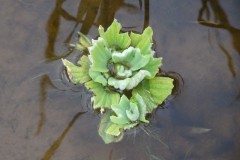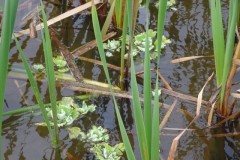Gosh! … It must have been a scorcher … Nile Cabbage in Balby!
On 3 October 2022 I came across a small population of about 10 rather tatty floating rosettes of the Nile Cabbage Pistia stratiotes at the edge of a small engineered lake (SE578009) on Balby Carr, sandwiched between the new Woodfield Way housing development and the Morrison’s (Balby Woodfield) Supermarket off Water Vole Way.
Although undoubtedly dumped here from someone’s aquarium or garden pond. It has probably survived here due to the notably hot summer. It would be interesting to see if it survives the first frosts of autumn.
In visiting the site with Nora on 6 October, we found two wind-disbursed flotillas of about 50 floating rosettes each, distributed amongst pond-edge Typha stems. The two excellent photographs taken as a record by Nora (see attached), shows that something has been feasting on the rosettes. Judging from the ‘V’ shaped peck marks, I suspect the ‘grazers’ may have been Coots. Good that someone’s making use of what otherwise might be regarded as an invasive alien.
Although the plant used regularly to be on sale in the aquarist sections of local garden centres and pet shops, I’ve not seen it in the wild.
Although Bob Marsh confirms this as the first entry for the species on the DMBC RECORDER database, Geoff Wilmore (2011) lists it in the South Yorkshire Plant Atlas (p.349) as “A casual escape from garden centres, aquaria, which occasionally becomes temporarily established in stream courses or other open water bodies.” The record he quotes is in the Sheffield region from the Old Hay Brook from Totley to Dore (SK3080), found by Ken Balkow 5 August 2006.
Background information from Wikipedia tells us: “Pistia is a genus of aquatic plants in the arum family, Araceae. It is the sole genus in the tribe Pistieae which reflects its systematic isolation within the family. The single species it comprises, Pistia stratiotes, is often called water cabbage, water lettuce, Nile cabbage, or shellflower. Its native distribution is uncertain but is probably pantropical; it was first discovered from the Nile near Lake Victoria in Africa. It is now present, either naturally or through human introduction, in nearly all tropical and subtropical fresh waterways and is considered an invasive species as well as a mosquito breeding habitat”.
Also present in the pond and still in flower, was a colony of the aquatic Monkeyflower Mimulus sp. a plant we also found in Worsborough Reservoir during our recent plant gall meeting.
This pond, created in the late 1990s as a rather stylish balancing reservoir for the anticipated built developments around Balby Carr, has now matured into a worthwhile habitat. Within its hinterland of hedgerows, tree-lines and long abandoned (and naturally re-wilding) agricultural land (see old OS maps), it is bursting with its own brand of urban green-space biodiversity. It would therefore be worth the Nats making a series of impromptu visits over the next 12 months.
From the Balby Sewage Works to the northwest, to the Woodfield Way dual carriageway to the south east, the site is served by a network of well used footpaths (desire lines) from the western ends of Woodfield Road and Weston Road, and from the adjacent new housing developments along Woodfield Way.
The White Rose Way Park & Ride is convenient for vehicular access and the adjacent Morrison’s Supermarket with its excellent café, car park and other conveniences would make an ideal operational HQ.
CAH
A single rosette of a Nile Cabbage Pistia stratiotes
A flotilla of rosettes of Nile Cabbage Pistia stratiotes
An Outing Bearing Fruit
On a glorious early autumn day, in fact the 23rd September, the day of the Autumn Equinox, the Nats (in the persons of Nora and myself) had been invited to accompany Angela Ganss (the DMBC ‘Future Parks’ Landscape Architect) to the Conisborough Crags Local Nature Reserve. The project was to identify, photograph and grid reference the locations of fruit-bearing trees and shrubs adjacent to the network of paths across the crags. The purpose of this venture, the idea of Tony Sellars, was to provide the basis of a map for the Friends of the Crags to use as a self-guided leaflet.
Despite the savagely hot and drought-ridden summer which had placed the plant communities under severe stress, the visit encountered an abundance of produce. Though some fruits could be used by the expert human forager, most would serve as autumn/winter food for our fellow creatures such as Squirrels, Jays, Blackbirds and Thrushes. Fruit and nuts ranged from the delicious and nutritious (Brambles, Apples and Hazel Nuts) to the emetic (Purging Buckthorn) to the downright toxic (Yew berries).
In all, the species recorded on the day were: Italian Alder Alnus cordata; Dogwood Cornus sanguinea; Hawthorn Crataegus monogyna; Spindle Euonymus europaeus; Ivy Hedera helix; Holly Ilex aquifolium; Apple Malus domestica; Cherry Prunus avium; Blackthorn Prunus spinose; Turkey Oak Quercus cerris; Holme Oak Quercus ilex; Sessile Oak Quercus petraea; Pedunculate Oak Quercus robur; Buckthorn Rhamnus cathartica; Dog Rose Rosa canina agg.; Burnet Rose Rosa spinossisima; Bramble Rubus fruticosus; Elderberry Sambucus nigra; Whitebeam Sorbus aria; Swedish Whitebeam Sorbus intermedia; Rowan Sorbus aucuparia; Yew Taxus baccata; Lime Tilia x europaea and Guelder Rose Viburnum opulus.
It would however be worthwhile, as at Glass Park in Edenthorpe, to introduce some more obviously edible varieties of Apples, Pears and Plums.
The air this afternoon was crystal clear, a legacy of successions of clean-air acts, so while wandering along the pathways traversing this elevated site we encountered staggering vistas out over the surrounding landscapes with the ability to see distant structures with pin-point accuracy … a phenomenon inconceivable prior to the 1950s.
A characteristic mewing call heralded the impressive sight of a large and laconic Buzzard gliding over the deciduous canopy of the woodland known from ancient times as ‘Denaby Thick’. With just a few flaps and glides the Buzzard made stately progress across to the tall woodland adjacent to Denaby Cemetery where it was rudely and noisily mobbed by a pair of Carrion Crows.
A falcon tracked overhead, systematically following the 70 metre contour around the Crags, prospecting for unwary avian prey. After a period of circling over the nearby newly mown sports field it purposely detoured to the north, flying high over Denaby Main with its grid of streets, schools, churches and green spaces laid out far below. In gaining height it became a mere speck and seemed to merge with the flat bases of the fair-weather cumulous clouds drifting over. Then, as if at the flick of a switch, just as the nature writers describe, and confirming its identity as a Peregrine, it closed its wings and plummeted like a dart in long perpendicular fall, vanishing amongst trees and structures of Denaby Main’s urban jungle … a heart-stopping moment. Later, in scanning the A to Z to find the falcon’s target spot, it looked like an unsuspecting bird had probably met its fate on the community cricket ground. No doubt a puff of pigeon feathers blowing in the wind somewhere near Tickhill Square would be the only evidence of this little but all too final drama.
CAH.
P.S . It was a delight to meet up with Angela and to be involved with this project. Apart from treading in some persistently pungent dog dirt; we all learned so much about the fascinating biodiversity and scenic splendours of this remarkable and well used local site.
A pendulous bouncing bounty
Over the past few years the front and rear garden, even the flag-paved drive at home in Balby have been invaded by self-seeded plants of the rather elegant, though increasingly dominant Pendulous Sedge Carex pendula.
The core of the original clump now measures 2.5m in diameter with tall arching seed-baring stems growing to a height of 1.8m. It now forms a dominant feature of the rear garden and along with woodland Geraniums and Lavatera, much beloved of Bumble Bees and Hover Flies, is overlooked by the conservatory.
This year the clump grew 73 rather graceful fertile stems, each producing 5 to 7 pendulous cylindrical female ‘spikes’ up to 20cm in length. The mean number of spikes per stem (based on a sample of 61 stems) was 6.3, each spike producing hundreds of seeds. Sadly much of this productivity has now been disbursed. However, the seeds from one reasonably complete spike were sloughed off onto a sheet of paper and (with difficulty) counted, revealing 227 seeds.
Thus the 73 stems produced a mean of 6.3 fruiting spikes each of which in turn produced approximately 227 seeds. Hence the entire clump could have produced 73 x 6.3 x 227 = 104,397 seeds.
On Sunday 11 September, while having a mug of tea in the conservatory and looking down the garden, I noticed the arching stems of the Pendulous Sedge vigorously bouncing up and down, giving the impression of herd of treadle sewing machines working at full tilt. This was in response to the local gang of House Sparrows enthusiastically harvesting the sedge seeds. A sparrow would briefly land on an arching stem which would collapse under its weight. The bird would then reach over to peck at an adjacent pendulous seed-laden spike, then fly off, leaving the stem to spring back. While away at a nearby perch it would process (de-chaff) the seeds in its internally grooved bill, then quickly return for the next beak-full of seeds.
This substantial ‘wild’ food resource for specialist seed-eaters, in this case the local population of 10 House Sparrows, potentially provided 10,439 seeds per bird. However, this busy little gang had the clump largely stripped during the period of a week, though there is no knowing how efficient their feeding technique was and what proportion of the seeds were lost to them and scattered for other member of the local biodiversity to harvest.
None the less, the sight of the bouncing sparrows was definitely a highlight of the year.
CAH.
Peregrine over Doncaster
On Thursday 16 December 2021 I visited Doncaster’s *Danum Gallery to inspect the Mayor’s Bog-oak Chair in advance of a proposal to date its timbers by means of dendrochronology. This impressive if bizarre piece of furniture is grandly exhibited among notable specimens relating to the River Don of yesteryear such as the 9ft Sturgeon which had been speared with a pitchfork by William Taylor in July 1860 at Barnby Dun and briefly ridden like a surf-board as it attempted to migrate upstream; a very fine Otter in the process of eating a Brown Trout; a sky-pointing Bittern and an 11½ lb female Salmon found expired after spawning in the Don at Doncaster in December 1995.
Although the gallery was temporarily closed to enable staff to install new display material, I was kindly allowed access to briefly inspect the chair.
Later, at 3.30pm in ‘Café 1910’ on the ground floor, the views overlooking the traffic snarl-ups on the Chequer Road/Wood Street/Waterdale roundabout were relieved by sightings of birds going to roost. These included passing Blackheaded, Lesser-blackbacked and Herring Gulls, Carrion Crows, Jackdaws, Magpies, Blackbirds, Starlings and Street Pigeons. In counting the town centre Pigeons settling on the west-facing roof ridges of the towering ‘JobcentrePlus’ headquarters on Wood Street, the 80+ strong flock suddenly exploded into flight being under attack by a Peregrine Falcon which made two unsuccessful but impressive stoops through the panicking birds.
*The Danum Gallery, the re-purposed Doncaster Girls High School, is the new display area for Doncaster Museum & Art Gallery.
CAHowes

